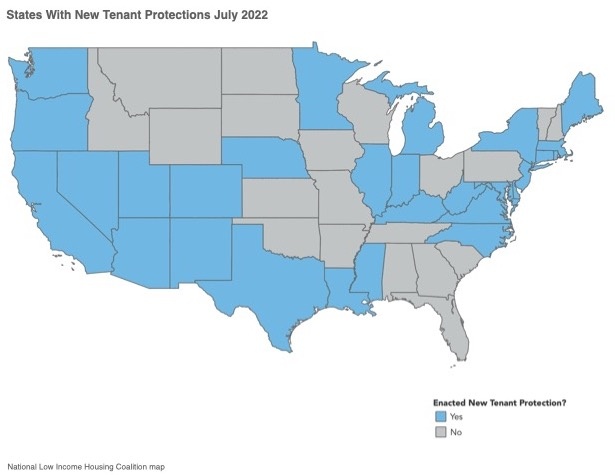INSTITUTE INDEX: COVID-era reforms bring lasting eviction relief

This map from the National Low Income Housing Coalition shows the states that have adopted eviction reforms since the start of the COVID-19 pandemic. To see a map of the localities that have adopted eviction reforms, click here.
Date on which the White House and U.S. Treasury Department held a "Summit on Building Lasting Eviction Prevention Reform" to discuss the impact of COVID-era policy reforms on eviction trends: 8/2/2022
Under the Emergency Rental Assistance Program Congress created in response to the COVID-19 pandemic, number of payments made nationwide for rental or utility assistance to individuals at risk of eviction: 7 million
Percent of those funds that have gone to very low-income renters, defined as those at or below 50% of the average median income: over 80
Rank of majority-Black neighborhoods — which normally experience a disproportionate number of evictions — among those that benefited most from the Emergency Rental Assistance Program: 1
Number of rental households nationwide who were saved from eviction by the nationwide moratorium issued by the Centers for Disease Control and Prevention, which was in place from September 2020 to August 2021: 1.55 million
Rank of the Emergency Rental Assistance Program and the federal eviction moratorium among the most important federal housing policies of the last decade, according to Matthew Desmond, founder of the Eviction Lab at Princeton University: 1
As a result of these and other reforms championed by the Biden administration, percent by which eviction filings have remained below historic averages since the federal eviction moratorium ended last August, based on an analysis of data collected by the Eviction Lab: 26
Month in which Associate Attorney General Vanita Gupta wrote a letter to state courts encouraging them to establish eviction diversion programs: 6/2021
In response, number of jurisdictions across 36 states that developed or enhanced eviction diversion programs: 180
Number of evictions prevented under the Texas Eviction Diversion Program, the first statewide program established in response to the pandemic: 21,000
Before the COVID-19 pandemic, number of U.S. cities that had legislatively adopted the right to counsel for tenants facing eviction: 5
Additional number of cities that have done so since, along with three states*: 10
Since January 2021, total number of tenant protections — including the right to counsel and requirements to seal eviction records, among others — that have been adopted across 31 states and 67 localities: 154
Of the states and localities, respectively, that adopted pandemic-era eviction protections, number in the South: 7, 13
Amount in Emergency Rental Assistance funds that New Orleans First City Court Chief Judge Veronica Henry — among the speakers at the recent White House summit — used to develop an ongoing eviction diversion program in partnership with the city, local courts, and nonprofits: $2 million
Number of New Orleans households the program has protected from eviction to date: at least 500
Date on which a U.S. Senate panel heard testimony from experts including Eviction Lab's Desmond, who warned that record rent increases coupled with expanding institutional investor ownership of housing are putting families at greater risk of eviction and homelessness: 8/2/2022
* The five cities that established the right to counsel prior to the COVID-19 pandemic were New York; San Francisco; Newark, New Jersey; Cleveland; and Philadelphia. Those that recently established it are Boulder, Colorado; Baltimore; Seattle; Louisville, Kentucky; Denver; Toledo, Ohio; Minneapolis; Kansas City, Missouri; New Orleans; and Detroit. The states that also established the right are Washington, Maryland, and Connecticut.
(Click on figure to go to source.)
Tags
Sue Sturgis
Sue is the former editorial director of Facing South and the Institute for Southern Studies.
